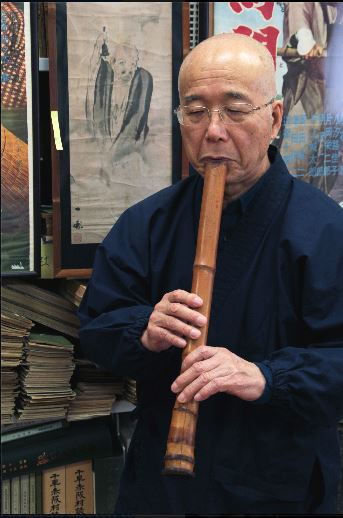Following the scent of roses blooming
on a residential street, I explore the town area of Haramachi, stopping at an
ochre-colored wall. Inside, I find Hosshinji, a 1631 Zen temple affiliated with
Engakuji in Kamakura.
Priest Daitetsu Kosuge, 73, waves me
inside, where he promptly prepares me some thick green tea. The wind outside
and the swish of the bamboo chasen (whisk) frothing the tea mingle
nicely.
In conversation, I gradually learn
that Kosuge harbors a special passion for the bamboo shakuhachi flute,
an integral part of the Fuke-shu sect of Zen Buddhism. “Monks once practiced suizen,
a form of prayer through playing basic meditative pieces, which were known as
the honkyoku,” he explains. “These monks — many of whom were samurai
that had lost their commissions once Japan was unified under the Tokugawa
shogunate — were known as komuso.”
Throughout the Edo Period (1603 —
1868), komuso, wearing their distinctive tengai (a woven bamboo or
rattan hood meant to render their own egos void), were offered rare license to
wander across the country’s borders freely, so as to visit other temples and
sustain their mendicant lifestyle. Kosuge suggests it might have been this
freedom of movement, plus their samurai training and secretive hood, which led
many to suspect the Komuso of moonlighting as spies for the shogunate.
The Meiji Restoration in 1868 greatly
curtailed the practice of Buddhism in favor of the Imperially-preferred Shinto
religion, and the practices of Komuso monks were banned. “The main Komuso
temple was only about 2 km from here,” Kosuge says, “So many of the monks took
refuge in this temple.” I contemplate the horror of being an egoless priest,
only to have even that practice voided.
Seeing that I’m keen on the subject,
Kosuge guides me to a temple room where he has stored more than twenty
shakuhachi. He plucks one off the rack, and as his breath enters the bamboo,
the sound blows away the afternoon. For all its overuse in documentaries and by
restaurants hoping to evoke a taste of Japan, to hear a well-played shakuhachi
in person is stirring.
Kosuge next shows me upstairs to his
museum of shakuhachi, Komuso songbooks, rare ephemera, woodblock prints and
unusual flutes. After the Meiji Era, the shakuhachi was taken up as a purely
musical instrument, but Kosuge sees a revival of interest in the classical
pieces these days, too.
At last, I (journalist Kit Nagamura) request a try at the
flute, ignoring the sexual innuendo often associated with women and shakuhachi.
Kosuge laughs as I struggle to establish an effective embouchure. When a note
purls out, it feels, frankly, as though my whole soul follows it as it floats
off. Kosuge nods. This makes sense to him.
I could blow off the rest of the day
with Kosuge, but knowing he must be busy, I excuse myself. Heading back toward
Okubo Avenue, the priest’s gentle humor and hospitality lingers like notes
well-played.

